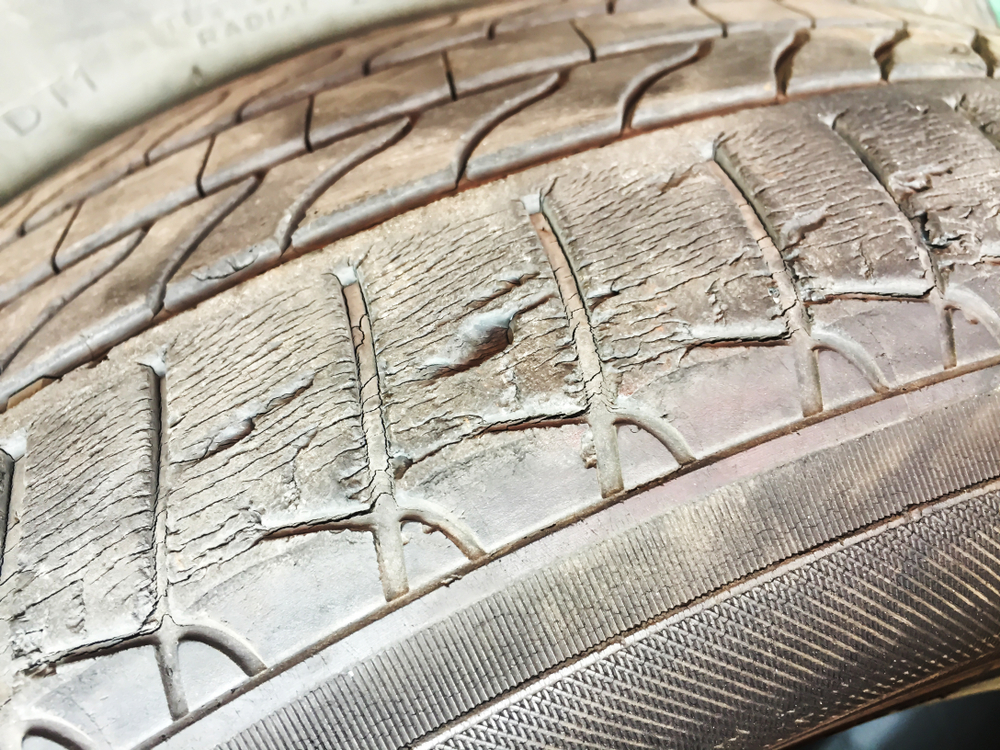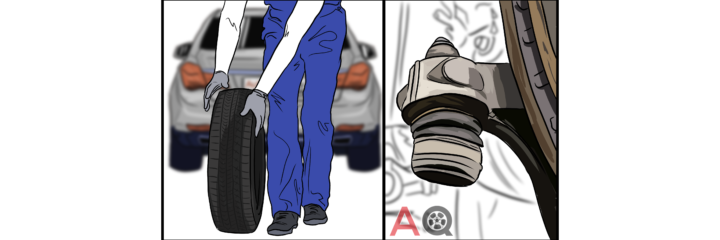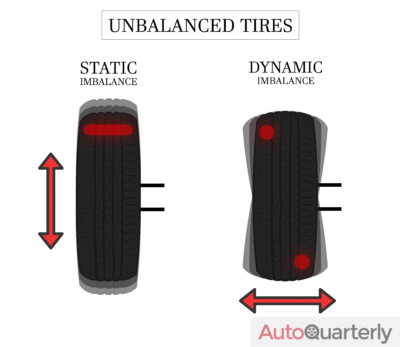Picture a scenario where you’re driving down the highway, and your car starts vibrating to the point where it’s difficult to steer. While your first instinct after you pull over might be to panic and wonder what’s wrong with your vehicle, there’s a good chance that it’s a relatively minor issue like unbalanced tires.
Much like other vehicle components, it’s vital to take care of your tires to ensure they live long lives. The better care you take of your rubber, the longer you can expect it to last and perform. When your tires are unbalanced, the rubber’s weight isn’t evenly distributed around the wheel, leading to premature wear and a bumpy ride whenever you take your car for a drive.
Here’s what you should know about unbalanced tires, including how to determine that you have unbalanced tires, and what to do about it.
What Are Unbalanced Tires?
In an ideal situation, your tires will be perfectly balanced around your wheels, and their weight is evenly distributed. With a balanced tire, you can expect a smooth ride and even wear on your rubber.
When a tire is unbalanced, the weight of the rubber and rim together isn’t evenly spread around the wheel. The result is a wheel that doesn’t spin evenly. When this occurs, you’ll experience uneven wear, and potential steering issues can make driving dangerous.
The good news is that unbalanced tires are a relatively easy and inexpensive problem to repair as long as you address the issue immediately before wear begins to affect different parts of the tire differently.
Unbalanced Tire Causes
There are a few different reasons why you could end up with unbalanced tires. In most cases, the problem isn’t caused by anything you do but rather by the things you don’t do to maintain your vehicle.
For starters, this issue tends to arise in high-mileage vehicles because of regular wear and tear. Over time, the tires simply unbalance as you drive, forcing you to address the problem. Getting your car in for routine maintenance can prevent this problem from occurring or, at the very least, allows your mechanic to rebalance your tires before they affect your ride. The issue can also happen when you’ve just recently installed tires, as a new set of rubber might need to be balanced before use.
There are also situations where routine driving incidents can lead to unbalanced tires, such as collisions. It doesn’t have to be a significant accident, as bumping a curb or rock or running over a pothole is sometimes enough to throw your tires out of balance.
If you’ve hit a pothole and have noticed your car behaving differently ever since, having the tires checked is a good idea.

Symptoms of Unbalanced Tires
You should always pay attention to your car as you drive it. Remember, you’re the first line of defense against significant vehicle problems because it’s up to you to notice when your car isn’t performing normally.
Get your car into the mechanic as soon as possible if you notice any of the following problems while driving to potentially limit the amount of damage or even save your tires.
Vibrations While Driving
One of the most common signs of unbalanced tires is a vibration while driving. While some small vibrations are typical, particularly if you’re traveling on a bumpy road, unbalanced tires can create severe vibrations that make the drive uncomfortable. You might even feel the vibrations throughout the whole car and into your steering wheel.
As you think about these vibrations, remember that other problems can cause them, too. Are the vibrations more severe when you push on the brakes? If so, the rotors could be the issue. Do the vibrations worsen as you accelerate, or do you smell burning when you stop? The brake calipers could be responsible for this situation.
When unbalanced tires are causing your vehicle to vibrate, your probably won’t even feel it at low speeds: your car will probably start shaking as you get to about 70 miles per hour, getting worse until you reach about 75 miles per hour. Once you reach higher speeds or slow down, the vibrations will likely stop.
The reason is that the vehicle’s weight is more pronounced at those speeds, so the tires’ uneven rotation causes vibrations. No matter the underlying cause, a vibrating car is uncomfortable and potentially dangerous, so getting your car into the shop immediately when feeling a significant vibration is incredibly important.
Steering Difficulties
Another problem you might encounter with unbalanced tires is difficulty when steering. It makes sense that steering would be affected, as the steering system connects to the tires. When the unbalanced tires cause vibrations, the wheels want to do their own thing, making it more challenging to control the car.
The vibrations can also cause delays or sluggishness in the steering system. This delay can be dangerous because it makes collision avoidance more difficult and your car less likely to track predictably.
Keep in mind that while this sluggishness won’t cause your car to go out of control, even a small delay or difficulty steering your vehicle could be the difference between getting into an accident and avoiding it.
Your steering problems could be the result of uneven wear on your tires, too. When one section of the tires is bald and another area has significant tread remaining, there’s a chance that part of your tire won’t even end up touching the road. This issue can cause steering and control difficulties, although this is generally a long-term problem associated with unbalanced tires. If your tire is worn unevenly, it’s likely you’ll have to replace it. This highlights the importance of treating the issue as soon as possible.
Early or Uneven Wear
A simple method of determining if your tires require balancing is to look at the tread. Generally, a balanced tire will have even wear throughout the rubber, while an unbalanced one has some worn-out spots and others in good condition.
The gist is that an unbalance tire puts pressure on some parts of the rubber while keeping other sections in like-new condition because they aren’t under any stress. The problem is that the tire is only as strong as its weakest point, so once one section of the tire experiences a significant amount of wear, the entire tire requires replacement.
You’ll likely find yourself having to change your tires more frequently when they’re unbalanced, which is a significant expense when it happens frequently.
Worsened Fuel Efficiency
Unbalanced tires cause the engine to work harder because they create resistance as you drive. The result is lower fuel economy, forcing you to fill your tank more often.
The reason for this occurrence is relatively straightforward. Since the car’s weight isn’t evenly distributed around the tires, the tires require more energy to rotate. Therefore, the engine has to work harder to maintain this rotation, burning fuel in the process.
While burning more gas isn’t a safety issue, it’ll cost you money every week. Balancing your tires reduces your fuel spend in the process. Since a tire balancing usually costs between $40 and $70, you’ll see savings almost immediately.
Bearing and Shock Problems
Finally, your unbalanced rubber could cause bearing and shock problems. The reason is that your unbalanced tires spin unevenly, which puts extra stress on your suspension, leading to damage.
All of your suspension components are connected. Therefore, when something out of the ordinary occurs, such as an unbalanced tire putting a strain on certain parts of the wheel, the wheel bearings also experience additional stress. These vibrations can also harm other parts of the suspension as well.
Wheel bearings are a far more expensive repair than tire balancing, so anything you can do to avoid this situation is advisable.
Also, the vibrations that an unbalanced tire creates are hard on your shocks. Much like driving on a bumpy road, your shocks can break down over time if you don’t address your unbalanced tires. Like the wheel bearings, shock absorbers are expensive to replace, and the repair will take longer.
Fortunately, all of these unbalanced tire symptoms are easily noticeable if you’re paying attention to your vehicle’s handling and performance. Getting your car into the shop early can prevent your unbalanced tires from turning into a much more severe issue.
When to Have Your Tires Balanced
While the symptoms of unbalanced tires give you a general idea of when it’s time to get a balancing done, there are other situations where it becomes necessary. These scenarios should be part of your contingency maintenance plan, ensuring that you don’t end up with damage to your car because of your unbalanced tires, but proper routine maintenance means you’ll rarely, if ever, have a problem with tire balancing.
For starters, you should balance your tires every 5,000 to 7,000 miles or so, as this allows you to get out front of issues before they damage the tires and other components. If you switch between summer and winter tires, having them balanced during your seasonal changeover is an easy way to ensure you get the job done.
If you frequently drive on roads in poor conditions, balancing your tires even more frequently is a good idea. That’s because the vibrations and bumps you’ll encounter on these roads tend to accelerate irregular wear and tear that causes a tire to become off-balance. This appointment should be on top of your regularly scheduled 5,000-mile balancing.
Whenever you get a flat tire and have to repair it, following up with a balancing is a good idea. Repaired tires often come out of balance and could throw the entire vehicle off. The same goes for replacing any single tire. The good news is that you’ll probably head to a mechanic for your tire replacement, so asking for a balancing is a quick and easy addition to your service.
There might be a weight attached to your rim when they are balanced. It’s rare, but these weights can actually fall off your vehicle, particularly after a collision or if you make frequent trips on bumpy roads. Missing this weight is a clear sign that your tires are unbalanced because the weight is responsible for balancing them. If you notice that this weight is no longer there, it’s time for a tire balancing.
By balancing your tires in these situations, you can avoid many of the problems that can arise later on.
How to Fix Unbalanced Tires
If you don’t have the necessary tools and expertise, balancing your tires is as simple as taking your car to a local mechanic. The process is relatively quick, simple, and inexpensive, so returning your tires to the optimal level isn’t much of a hassle.
Not only does taking your vehicle to a certified mechanic reduce your workload, but you can also have confidence that a professional with loads of experience is working on your tires. It’s inexpensive as well, so unless you’re an experienced mechanic that does nearly all of their work and has all the necessary tools, it’s probably easier and more convenient to just take them into a shop. It can typically be done on the spot and costs around $25 to $80.
However, some car owners prefer doing these jobs themselves. If you fall into this category, you should know that you’ll need a tire balancer, some weights, a jack, and a wrench to complete the job.
Tire balancers are specialized pieces of equipment, but they aren’t overly expensive. You can usually buy one for under $100, so if you plan on balancing lots of tires, it could be a worthwhile investment.
The process is started by removing all of your vehicle’s tires and their current weights. From there, you’ll put the tire and wheel onto the balancer and follow the instructions its manual provides. Different balancers work in different ways, but they’re generally straightforward devices.
The tire balancer spins and measures the vibrations that occur. These measurements tell you where the weight is spread evenly and where the tire is unbalanced. The balancer indicates the parts of the tire that require a weight, so you’ll want to mark them off and add the weights.
Once you install the weights, return the tire to the balancer and check again. You’ll have to repeat this process until the tire is moving correctly in the balancer with no uneven weight, and then do the same for the rest of your tires.
Wrapping Up
On their own, unbalanced tires are a relatively minor issue that you can repair quickly. However, this problem can damage other vehicle components and become a safety hazard if you don’t address it quickly. When the time comes to balance your tires, you can either handle the job yourself or head to a mechanic. The most important lesson is to pay attention to your car so you can identify the symptoms of unbalanced tires as you drive.



